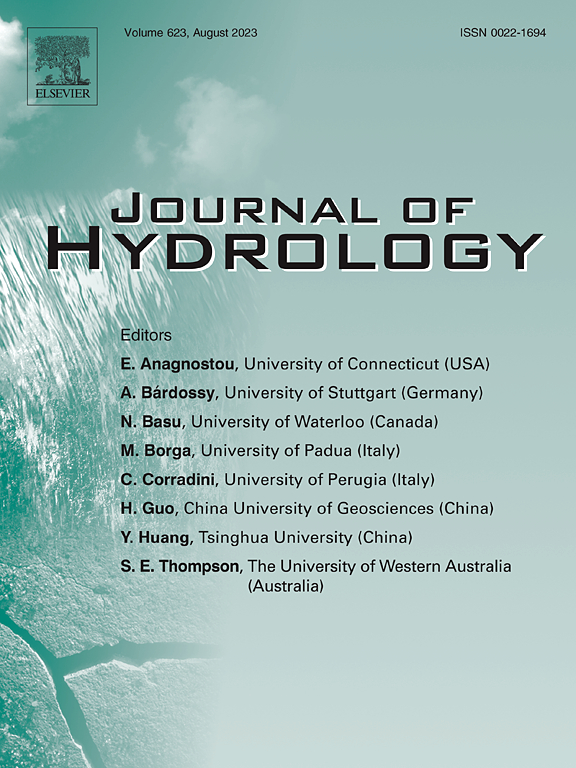Oyster farming and hydrodynamic conditions regulate composition and sources of sedimentary organic matter in a typical river-estuary-bay continuum
IF 5.9
1区 地球科学
Q1 ENGINEERING, CIVIL
引用次数: 0
Abstract
Estuaries and bays provide favorable conditions for mariculture, which in turn influences regional carbon cycling. However, a key challenge lies in comprehending the role of mariculture in sedimentary organic matter (SOM) dynamics during the transport of organic carbon (OC) along river-estuary-bay continuums. To address this knowledge gap, surface sediments were collected from a typical oyster farming area, i.e. the lower reaches of Dafeng River (LDR) to Dafeng River Estuary (DRE) and adjacent Qinzhou Bay (QZB). The sediments were analyzed for total OC (TOC) and nitrogen (TN), as well as stable isotopic composition (δ13C and δ15N) to determine the source and fate of SOM. The results revealed higher TOC and TN contents in DRE than LDR and QZB due to an increased proportion of fine-grained components, which was caused by weak hydrodynamic sorting in the estuary. Bayesian mixing model based on δ13C and TOC/TN ratio indicated that shellfish biodeposition was an important source of SOM, with an annual mean contribution of 36.6 ± 8.0 %. Notably, despite the small scale of oyster farming in QZB, shellfish biodeposition contributed 39.3 ± 6.2 % to SOM, suggesting that intensive oyster farming in the estuary reshaped the composition of SOM in the bay. Furthermore, terrestrial input made a significant contribution to SOM during summer in QZB compared to DRE due to remineralization of labile shellfish-derived OC during transport from the estuary to bay. Overall, this study highlighted the substantial impact of oyster farming and hydrodynamics conditions on SOM dynamics in coastal waters.

牡蛎养殖和水动力条件调节了典型河流-河口-海湾连续体中沉积有机质的组成和来源
河口和海湾为海水养殖提供了有利条件,进而影响区域碳循环。然而,一个关键的挑战在于理解海水养殖在河流-河口-海湾连续体中有机碳(OC)运输过程中沉积有机质(SOM)动力学中的作用。为了解决这一知识空白,我们收集了典型牡蛎养殖区(即大丰河下游至大丰河口及邻近的钦州湾)的表层沉积物。分析沉积物的总OC (TOC)和总氮(TN)以及稳定同位素组成(δ13C和δ15N),以确定SOM的来源和去向。结果表明,DRE中TOC和TN含量高于LDR和QZB,这是由于河口水动力分选作用弱导致的细粒组分比例增加所致。基于δ13C和TOC/TN比值的贝叶斯混合模型表明,贝类生物沉积是SOM的重要来源,年平均贡献率为36.6±8.0%。值得注意的是,尽管QZB牡蛎养殖规模较小,但贝类生物沉积对SOM的贡献为39.3±6.2%,表明河口集约化牡蛎养殖重塑了海湾SOM的组成。此外,与DRE相比,陆地输入对QZB夏季SOM的贡献显著,这是由于从河口到海湾的运输过程中不稳定的贝类OC的再矿化。总体而言,本研究强调了牡蛎养殖和水动力条件对沿海水域SOM动力学的重大影响。
本文章由计算机程序翻译,如有差异,请以英文原文为准。
求助全文
约1分钟内获得全文
求助全文
来源期刊

Journal of Hydrology
地学-地球科学综合
CiteScore
11.00
自引率
12.50%
发文量
1309
审稿时长
7.5 months
期刊介绍:
The Journal of Hydrology publishes original research papers and comprehensive reviews in all the subfields of the hydrological sciences including water based management and policy issues that impact on economics and society. These comprise, but are not limited to the physical, chemical, biogeochemical, stochastic and systems aspects of surface and groundwater hydrology, hydrometeorology and hydrogeology. Relevant topics incorporating the insights and methodologies of disciplines such as climatology, water resource systems, hydraulics, agrohydrology, geomorphology, soil science, instrumentation and remote sensing, civil and environmental engineering are included. Social science perspectives on hydrological problems such as resource and ecological economics, environmental sociology, psychology and behavioural science, management and policy analysis are also invited. Multi-and interdisciplinary analyses of hydrological problems are within scope. The science published in the Journal of Hydrology is relevant to catchment scales rather than exclusively to a local scale or site.
 求助内容:
求助内容: 应助结果提醒方式:
应助结果提醒方式:


